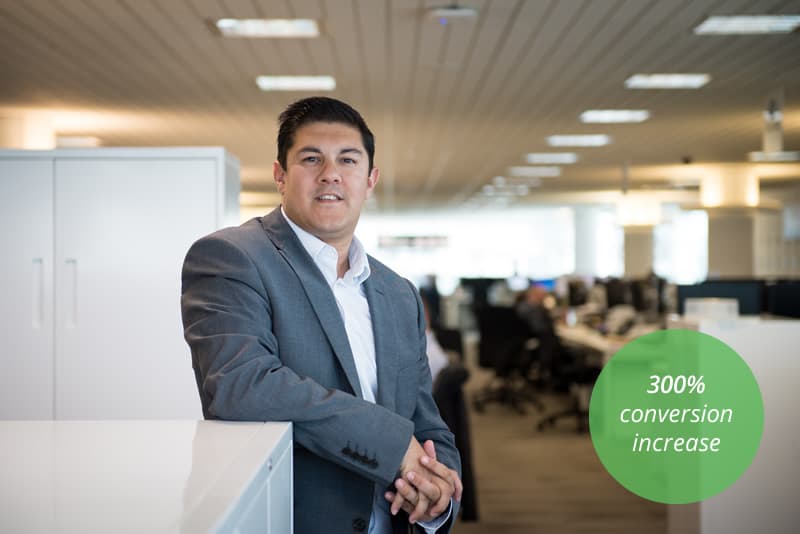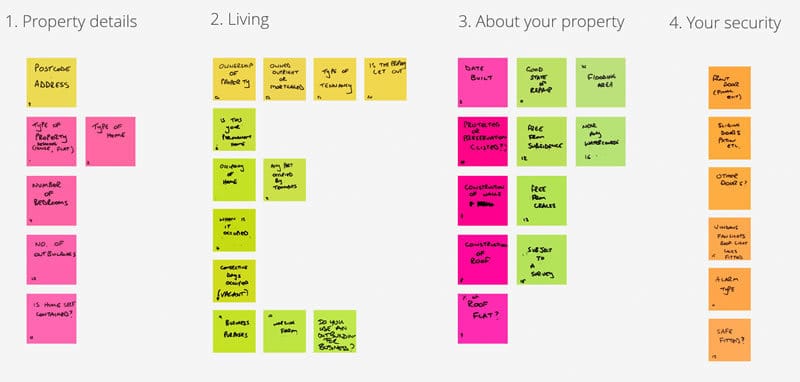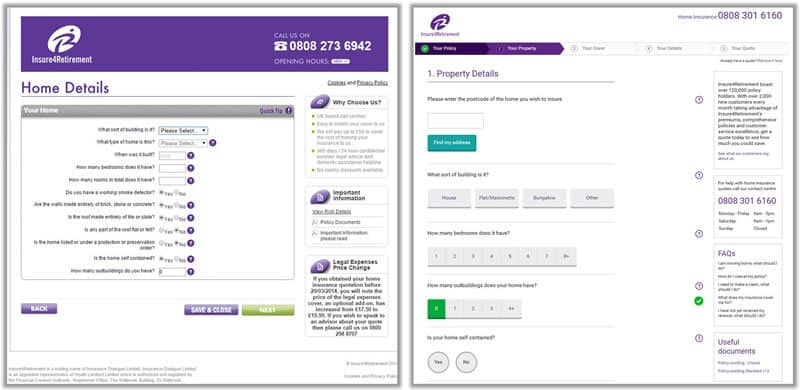Insure4Retirement (I4R) is an online home insurance broker specialising in the over 50s market. Here, we talk to Lee Hill, E-Commerce Consultant at I4R, about how our UX research process fed into the project to drive better conversion results and provided a strong case for UX in all projects.

“Results speak volumes. That was why we needed to engage with a really good UX agency”
What were you hoping to gain from working with an external UX team?
The project was to develop a system, a quote and buy journey specifically, that we could roll-out across the other products and businesses in the AJG group. It was going to be a large-scale build and therefore we wanted to do the research upfront to get that journey right. We didn’t want to be throwing anything away post development – that was really key for us, so investing in the research stage would make sure we got the reward out of the end build.
Once users have landed on the site, my job is to get them to quote. What I do, and where our business is at the moment, is very numbers driven. We’re becoming more customer-centric, but right now it’s the numbers that matter. Results speak volumes. That was why we needed to engage with a really good UX agency.
I think that using specialist agencies working within a specific niche is the best way to bring in the right experience and skillsets to make a project work. For us, an agency is a business partner. They understand our business and our requirements in a detailed way. In the same way that you naturally use a design and development agency to build a website, we see Experience UX as part of our process now. They’re almost part of our ecosystem.
We had some initial kick-off discussions and it felt like a really good fit, especially given Experience UX’s work in Financial Services. The methodology made sense. There was no trying to plaster us with science; it was a very clear, methodical process, and you could see where you were going to get value from it.
One of the interesting things about utilising a UX process is that you end up pulling out things that make you think: “We should have known that. That was so obvious.” For example, during the User Profiling project we came up with an additional core audience, people phoning for insurance for their older relatives or friends, which operationally the business was aware about but product marketing teams weren’t. The reality is, you don’t necessarily hear about these things, so when you do hear it from people, operations and customers you take a lot more notice.
“If we hadn’t run usability testing we’d have been guessing at a solution, and that was too big a gamble”
What did you want to focus on in UX testing?
There are so many different stages and questions in a quote and buy journey that there’s a big risk of drop-off in terms of struggling with functionality, not understanding the language, or just feeling the journey is too long. With so many variables that could go wrong, we felt that we needed to find out from our actual users how to perfect the journey. If we hadn’t run usability testing, we’d have been guessing at a solution and that was too big a gamble.
From the 30 prioritised recommendations from Experience UX, 15-20 of them were things that we wouldn’t have picked up as causing as much issue as they actually did. It was fascinating to see how negatively users felt about supplying personal information on the first page. We found that if we asked about their personal contact details later in the journey, once they’d built their product, they were a lot more accepting. Without identifying this key element, we wouldn’t have taken the approach we did.
IA Workshop output – structuring a user friendly quote form
Once we had the report of recommendations, Experience UX facilitated a workshop with my team and our design agency to map out the wireframe process. We walked through the process by looking at our current question set, how we might change it to coincide with the recommendations, and how we might change specific questions. It was something I’d not done to that depth before in such a collaborative way. The blueprint it provided added immense value to briefing in the full design and development process.
“… the knowledge we learnt through the UX process put us in a better position to deal with the challenges of development”
What did you learn from the research?
The benefit of UX research is that it removes the influence of somebody internally making a call on something. It takes the subjectivity out of it and says: “Actually, the only people who really care here are our actual users. We’ve tackled that question during the UX and our users prefer to do it this way.
Without a doubt, the knowledge we learnt through the UX process put us in a better position to deal with the challenges of development. It took the challenge out of conversations that at times became quite heated because there were a lot of passionate, creative people in the process. If you haven’t got the evidence to say what’s important to users, then you can be influenced into doing something you’re not sure is right.
Following the quote and buy journey project, we expected that conversions would be strong but not as strong as they actually were. When we looked at the conversion numbers of the funnel, it was performing so well that it was clear that the brochure site was where we needed to focus all our attention next. We were expecting to have to do a piece of work in terms of how we push people from the brochure site into the quote and buy journey, as well as how we push people through the quote journey itself. The success of the UX project, to the conversion numbers, made it far easier for us to suggest that we also undertake a UX process for the brochure site.
“…the previous 6% overall visitor to quote completion rate has increased to over 20%. It was remarkable”
Now the quote and buy project is live, what are the results like?
We did a crazy thing and pushed the project live at all the wrong times. It was on a Friday just before Christmas and we were going through an IT change phase, but we needed to get this project live and ready for the New Year. It was literally hit the button and hope it would come together and perform.
When we launched, we didn’t even have any tracking live on the system. We had a live web recording system in place so I was having to go in and watch sessions of people going through the journey. It was just before Christmas, but the initial results were looking really good.
The proof of the pudding was going to be after the Christmas break as, with home insurance, January is one of the peak months. The conversion results went through the roof so all the pain was worth it!
Prior to starting the project, from a quote start to quote completion – that’s the number of people who get to the quote and buy journey and then reach the point where they get a price – we were converting about 37%. Now it’s hitting 77%. With some recommended tweaks to the brochure site, following a second usability test, the previous 6% overall visitor to quote completion rate has increased to over 20%. It was remarkable.
For the I4R business, it’s been a game-changer. It dramatically reduced all our digital marketing costs for sales, and we went down to double digit figures in terms of CPA spend as well. It was a huge success. Reducing the digital marketing costs for sales puts the business on a footing to aggressively grow if it wants to.
“Building in UX as a natural stage of the process drives better results and reduces the risk of the outcome as well”
What are the biggest positive learning points you’ll take away from the project?
Our key learning is the value of UX. It’s now something that we’re keen to ensure other areas of the business utilise if they’re undertaking web development. Building in Usability Testing as a natural stage of the process drives better results and reduces the risk of the outcome as well. These days everything’s moving so quickly and there’s a lot of pressure to make sure you’re performing. Working with Experience UX eliminates a lot of the risk and guesswork for everybody.
Home Details, before (left) and after (right) the UX process
If I’d done anything differently, I’d have probably brought more teams together earlier. There were some agencies within the project that weren’t used to our sector and if they’d been part of the whole workshop process and the earlier stages of seeing the UX process in play, I think they would have grasped certain aspects more quickly.
The development was challenging and it was probably two of the most intense months of my life. But when you launch something and it’s such a success, it makes it worthwhile. It would have been a different story if we’d have gone into this blind with just a brief from our team to the design agency, cutting out the whole UX process.
As for the challenges that lie ahead, it’s fair to say that as a business we were a few years behind the major players. In terms of the quote and buy process, this project has brought us in line with those guys now. We can get on with basic acquisition work and, as we know it’s going to work, we can grow and optimise that.
There’s still lots to do. We’re just getting going and that’s very exciting.
————
Thanks for reading. If you would like to talk to us about this project and the methods we executed please get in touch.



